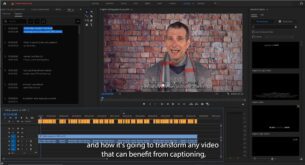OK, I’ll be honest, the headline is strictly for grabbing eyeballs. Still, on several videos that I checked, Adobe is using HTML5 for delivery, rather than Flash, going as far as to encode in VP8 for Firefox playback (rather than falling back to Flash and using H.264). Here’s the short backstory.
I received an email from Adobe’s PR team to watch a video about the production of the movie Gone Girl with Adobe Premiere Pro. I wanted to see if the producers mentioned my book, Premiere Pro CC; Visual QuickStart Guide (shameless plug; they, of course, didn’t) so I clicked over to the site, and by force of habit, right-clicked to see the player. Here’s what I saw.

No Flash Player! I was surfing in FireFox to access Download Helper to try to download the file. If the file was delivered in Flash via the Adobe Media Server (and RTMP), as Adobe video files have been in the past, Download Helper wouldn’t have worked. However, it worked like a charm; in fact, if you check the figure above you’ll note I could have downloaded the file directly.
The downloaded file turned out to be in WebM format; no surprise there, since Firefox doesn’t play H.264 natively within the browser (I know, there’s an OS-based workaround, but apparently Adobe didn’t use it). Here’s what MediaInfo said about the file.

It’s VP8 with Vorbis audio in a WebM container. Again, no surprise, this is what Firefox (and Opera and Chrome) support natively. Interestingly, Adobe is distributing in a format that Adobe Media Encoder doesn’t support, and as the next screen shows, seem to be producing some files (if not this one) using Zencoder, rather than their own encoding tools. Great move by Adobe–if you don’t think it’s time to start thinking about cloud encoding, you’re already way too late.
After downloading and analyzing this file, I checked the same page in Chrome to see how that file was configured-it was H.264 with the following specs. Again, no surprise, though Google proudly and very publicly announced that they were going to remove H.264 playback from Chrome, they (wisely and very quietly) never did.

I highlighted Zencoder in the figure above for obvious reasons.
I highlighted Baseline in a mini-hijack of the conversation. Specifically, I’ve long advocated using the Baseline profile exclusively to create a single stream compatible with all target playback platforms, rather than multiple streams (or multiple groups of streams) customized for the target platform (See H.264 in a Mobile World: Adios to the Main and High Profiles). Basically, as you’ll see in the article, the difference in quality between the High and Baseline profile was just too small to justify the hassle and expense of creating additional streams. Adobe certainly seems to have adopted the same approach, creating a single Baseline stream rather than High for computer playback, Main for iOS and Baseline for Android (as some consultants and cloud encoding services recommend).
A couple of final notes. First, these videos are not protected via DRM or monetized, which makes using HTML5 easier, and the video is single stream only, not adaptive. Though the Media Source Extensions and Encrypted Media Extensions will someday enable adaptive, DRM and monetization via HTML5, they still have a ways to go (see, Will MSE/EME/DASH Lead to Simpler Workflows? Don’t Bet on It).
Finally, Adobe has been publicly promoting HTML5 over Flash for general-purpose use for a while now, it’s good to see they’re drinking their own Kool-Aid. I checked around on the Adobe site and found several pages where HTML5 was used instead of Flash, including the keynotes from Adobe Max. I don’t know when Adobe made the change, or if it is universal on their site, but if your website is distributing single streams of video that are not monetized or protected (or live), it’s probably time for you to start thinking about HTML5.
Now if Adobe could just get the word to the Adobe Media Encoder team and get WebM (and VP9) encoding in their flagship encoder
 Streaming Learning Center Where Streaming Professionals Learn to Excel
Streaming Learning Center Where Streaming Professionals Learn to Excel







